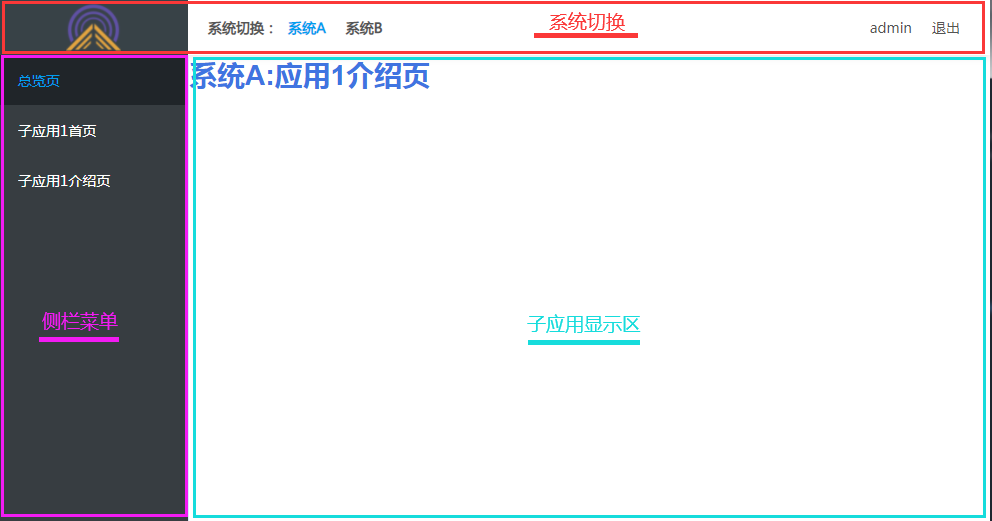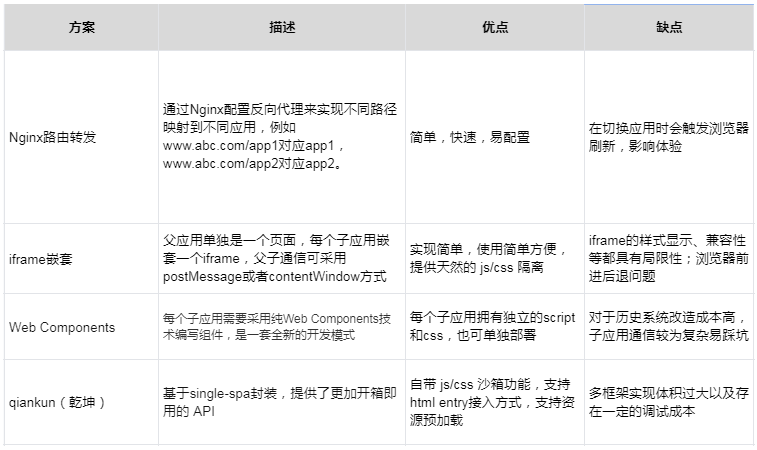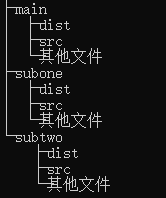qiankun微前端项目实践方案(基础框架篇)
一、前言
相信大家对于微前端的概念和思想都有了解过,在此我不再赘述。在我们的业务项目中,由于项目比较大,在日常的开发过程中也暴露出来了问题:项目启动慢,打包部署上线慢。这给我们开发和运维人员带来了很大的不便,有时候有紧急任务需要上线,也得打包半个钟才能交付到运维处。因此,我们打算使用微前端的方案,来解决我们目前的困境。下面我以一个简化版本的 demo,进行我们实践的介绍。 demo 源码放在 github 上:https://github.com/xiaohuiguo/qiankun-vue-ts-demo 。
二、项目简介
项目划分为几个模块系统:
主应用:【头部+侧栏+总览页+登录页】
系统A:应用1【首页+介绍页】
系统B : 应用2【首页+介绍页】
项目页面视图:

结构介绍:
我们根据业务情况划分了,主应用、子应用;
主应用主要是主框架结构,包含头部侧栏以及控制页面显示区域,另外对于一些常规页(登录/总览入口/注册)这类的页面直接放在主应用即可。
子应用则按业务情况,进行划分,这里我分成了 应用1 和 应用2。
系统操作演示:

三、技术选型
以下是目前比较流行的几种方案对比(参考了网上一些总结的不错的资料):

框架思考:考虑到业务以及团队技术水平情况,我们选择了qiankun(乾坤)作为我们的微服务接入框架,vue+ts作为项目主开发框架。主要是qiankun的接口封装的比较好,也比较容易上手,对于我们目前团队的能力,是可以接受的。
四、qiankun 框架构建
1.主框架应用
1.1 路由及视图设计
首先,一般项目都是有一个登录页的,在登录页不加载子应用,只有通过登录成功后,跳到控制台子应用的页面时,才进行加载子应用的。在本项目中,如果是打开主应用的页面都是不会去加载子应用的;
主应用的页面有登录页,总览页(属于控制台),路由如下:
/login
/gernal
在本项目中,子应用都是在控制台展示的,当打开子应用的路由时,就会触发子应用资源的加载,子应用路由如下:
/subone/**
/subtwo/**
针对以上情况,我们的视图区要做3种类型的视图区兼容
- 非控制台的页面显示区(如登录页),使用
router-view - 控制台主应用页面的显示,使用
router-view - 控制台子应用页面的显示,使用
<div id="subapp-viewport"></div>
当路由切换时,这里使用一个变量viewType来进行判断,切换视图区;另外,系统切换时我们头部系统显示以及侧栏也需要进行变化,这里使用一个变量menuType来进行判断:
// App.vue
<template>
<div class="home-container">
<!--主应用非控制台页面展示区:比如登录-->
<router-view v-if="status.viewType === 'full'"></router-view>
<!--控制台页面展示区-->
<div style="width: 100%;height: 100%;" v-show="status.viewType !== 'full'">
<div class="home-header box">
<header-nav :menuType=status.menuType></header-nav>
</div>
<div class="home-content box">
<div class="home-nav">
<ul class="nav-menu-admin">
<li class="nav-menu-item" v-for="(item, i) in navActive" @click="skip(item.path)">
<span slot="title">{{item.name}}</span>
</li>
</ul>
</div>
<!--主应用页面展示区-->
<router-view v-show="status.viewType === 'control_main'"></router-view>
<!--子应用页面展示区-->
<div id="subapp-viewport" class="flex" v-show="status.viewType === 'control_sub'"></div>
</div>
</div>
</div>
</template>
// App.vue
private status: any = {
viewType: 'control_main', // 页面视图类型 {String} --full:非控制台部分| control_main:控制台主应用|control_sub:控制台子应用;用于控制视图展示区切换
menuType: 'sysA' // 导航类型 {String} -- sysA:系统A| sysB:系统B;用于控制左侧菜单切换
}
private getPageStatus(index: any) {
console.log(index)
if (['login'].indexOf(index) > -1) {
this.status.viewType = "full";
} else if ([ 'gernal'].indexOf(index) > -1) {
this.status.viewType = "control_main"
} else {
this.status.viewType = "control_sub"
}
this.$forceUpdate();
}
private filterMenu(route: any) {
let menuType = route.path.split('/')[1];
switch (menuType) {
case 'subtwo':
this.status.menuType = 'sysB';
break;
default:
this.status.menuType = 'sysA';
break;
}
this.navActive = this.nav[this.status.menuType];
}
@Watch('$route') changeRoute(to: any, from: any) {
this.navActive = this.nav[this.status.menuType];
console.log(to, from)
let menuType = to.path.split('/')[1];
this.filterMenu(to);
this.getPageStatus(menuType);
}
1.2 子应用注册
子应用信息配置包括路由触发值,端口,以及视图区的容器
// main.ts
// 子应用端口
const MicroAppsPort: any = {
VUE_APP_SUB_ONE: 8081,
VUE_APP_SUB_TWO: 8082
}
function getEntry(name: any) {
const entryUrl = '//' + environment['host'] + ':';
return entryUrl + MicroAppsPort[name] + '/'
}
// 构建子应用, #subapp-viewport为子应用容器
const appsRouter: any = [
{
name: 'subone',
entry: getEntry('VUE_APP_SUB_ONE'),
activeRule: '/subone',
},
{
name: 'subtwo',
entry: getEntry('VUE_APP_SUB_TWO'),
activeRule: '/subtwo',
}
]
const microApps: any = appsRouter.map((item: any) => {
return {
...item,
container: '#subapp-viewport', // 子应用挂载的div
props: {
routerBase: item.activeRule, // 下发基础路由
window: window // 保持父子公用同一个window
}
}
});
使用qiankun提供的api进行子应用的注册及微服务启动
// main.ts
// 注册子应用
registerMicroApps(microApps);
// 启动微服务
start();
1.3 mait.ts和App.vue完整代码
// mait.ts完整代码
import Vue from 'vue'
import App from './App.vue'
import router from './router'
import { registerMicroApps, start } from 'qiankun'
import {environment} from "@/environment/environment";
// 组件总的样式
import '@/assets/sass/index.scss';
// 渲染主应用, #app为主应用根元素
new Vue({
router,
render: h => h(App)
}).$mount('#app')
// 子应用端口
const MicroAppsPort: any = {
VUE_APP_SUB_ONE: 8081,
VUE_APP_SUB_TWO: 8082
}
function getEntry(name: any) {
const entryUrl = '//' + environment['host'] + ':';
return entryUrl + MicroAppsPort[name] + '/'
}
// 构建子应用, #subapp-viewport为子应用容器
const appsRouter: any = [
{
name: 'subone',
entry: getEntry('VUE_APP_SUB_ONE'),
activeRule: '/subone',
},
{
name: 'subtwo',
entry: getEntry('VUE_APP_SUB_TWO'),
activeRule: '/subtwo',
}
]
const microApps: any = appsRouter.map((item: any) => {
return {
...item,
container: '#subapp-viewport', // 子应用挂载的div
props: {
routerBase: item.activeRule, // 下发基础路由
window: window // 保持父子公用同一个window
}
}
});
// 注册子应用
registerMicroApps(microApps);
// 启动微服务
start();
// App.vue完整代码
<template>
<div class="home-container">
<!--主应用非控制台页面展示区:比如登录-->
<router-view v-if="status.viewType === 'full'"></router-view>
<!--控制台页面展示区-->
<div style="width: 100%;height: 100%;" v-show="status.viewType !== 'full'">
<div class="home-header box">
<header-nav :menuType=status.menuType></header-nav>
</div>
<div class="home-content box">
<div class="home-nav">
<ul class="nav-menu-admin">
<li class="nav-menu-item" v-for="(item, i) in navActive" @click="skip(item.path)">
<span slot="title">{{item.name}}</span>
</li>
</ul>
</div>
<!--主应用页面展示区-->
<router-view v-show="status.viewType === 'control_main'"></router-view>
<!--子应用页面展示区-->
<div id="subapp-viewport" class="flex" v-show="status.viewType === 'control_sub'"></div>
</div>
</div>
</div>
</template>
<script lang="ts">
import {
Component,
Vue,
Watch
} from 'vue-property-decorator';
import HeaderNav from "@/components/header-nav/header-nav.vue";
@Component({
components: {
HeaderNav
}
})
export default class App extends Vue {
$router: any;
private $route: any;
private isLoading: boolean = true;
private $window: any;
private user: any = {
email: 'admin'
};
private status: any = {
viewType: 'control_main', // 页面视图类型 {String} --full:非控制台部分| control_main:控制台主应用|control_sub:控制台子应用;用于控制试图展示区切换
menuType: 'sysA' // 导航类型 {String} -- sysA:系统A| sysB:系统B;用于控制左侧菜单切换
}
private nav: any = {
sysA: [
{
name:'总览页',
path:'/gernal'
},
{
name:'子应用1首页',
path:'/subone/home'
},
{
name:'子应用1介绍页',
path:'/subone/about'
},
],
sysB: [
{
name:'子应用2首页',
path:'/subtwo/home'
},
{
name:'子应用2介绍页',
path:'/subtwo/about'
}
]
};
private navActive:any = [];
@Watch('$route') changeRoute(to: any, from: any) {
this.navActive = this.nav[this.status.menuType];
console.log(to, from)
let menuType = to.path.split('/')[1];
this.filterMenu(to);
this.getPageStatus(menuType);
}
/**重置头部导航/侧栏菜单显示 */
private filterMenu(route: any) {
let menuType = route.path.split('/')[1];
switch (menuType) {
case 'subtwo':
this.status.menuType = 'sysB';
break;
default:
this.status.menuType = 'sysA';
break;
}
this.navActive = this.nav[this.status.menuType];
}
/*重置容器显示情况*/
private getPageStatus(index: any) {
console.log(index)
if (['login'].indexOf(index) > -1) {
this.status.viewType = "full";
} else if ([ 'gernal'].indexOf(index) > -1) {
this.status.viewType = "control_main"
} else {
this.status.viewType = "control_sub"
}
this.$forceUpdate();
}
private skip(url:any) {
this.$router.push(url);
}
private mounted() {
/**整理页面 */
let menuType = this.$route.path.split('/')[1];
this.getPageStatus(menuType);
/**整理导航 */
this.filterMenu(this.$route);
}
}
</script>
<style lang="scss">
....
</style>
2. 系统A:子应用1(系统B同理)
2.1 main.ts修改
由于用的是history路由模式,子应用需要兼容qiankun框架嵌入时的应用base路径
// main.ts完整代码
import './public-path.ts'
import Vue from 'vue'
import VueRouter, { NavigationGuardNext, Route } from 'vue-router'
import App from './App.vue'
import routes from './router'
Vue.config.productionTip = false
let router = null
let instance: any = null
const _window: any = window
function render ({props, routerBase}: any = {}) {
router = new VueRouter({
// 子模块是history路由时,处理basi url
base: _window.__POWERED_BY_QIANKUN__ ? routerBase : '/',
mode: 'history',
routes
})
instance = new Vue({
router,
render: h => h(App)
}).$mount(props ? props.querySelector('#app') : '#app')
}
// 本地调试
if (!_window.__POWERED_BY_QIANKUN__) {
render()
}
// 导出生命周期
export async function bootstrap () {
console.log('应用1启动')
}
export async function mount (props: any) {
console.log('应用1挂载', props)
render(props)
}
export async function unmount () {
instance.$destroy()
instance.$el.innerHTML = ''
instance = null
router = null
}
2.2 path_public.ts修改,兼容qiankun加载情况下应用的端口,并且需要在上面main.ts中引入
const _window: any = window
if (_window.__POWERED_BY_QIANKUN__) {
if (process.env.NODE_ENV === 'development') {
// eslint-disable-next-line
__webpack_public_path__ = `//localhost:${process.env.VUE_APP_PORT}${process.env.BASE_URL}`;
} else {
// eslint-disable-next-line
__webpack_public_path__ = _window.__INJECTED_PUBLIC_PATH_BY_QIANKUN__;
}
}
2.3 添加vue.webpack.js和端口配置
devServer的端口改为与主应用配置的一致,且加上跨域headers和output配置
// vue.webpack.js
const { name } = require('./package.json')
const webpack = require('webpack');
module.exports = {
transpileDependencies: ['common'],
chainWebpack: config => config.resolve.symlinks(false),
configureWebpack: {
output: {
// 把子应用打包成 umd 库格式
library: `${name}-[name]`,
libraryTarget: 'umd',
jsonpFunction: `webpackJsonp_${name}`
},
plugins: []
},
devServer: {
port: process.env.VUE_APP_PORT, // 端口配置
headers: {
'Access-Control-Allow-Origin': '*'
}
}
}
// .env
VUE_APP_PORT=8081
五、部署
5.1 应用打包【以https://github.com/xiaohuiguo/qiankun-vue-ts-demo为例子】
主应用打包
cd main
npm install
npm run bulid
子应用1打包
cd subone
npm install
npm run build
子应用2打包
cd subtwo
npm install
npm run bulid
目录结构如下:

5.2 修改nginx配置文件
以项目代码放在/var/www/html目录下为例,所有应用部署在同一台机器上:
http {
include mime.types;
default_type application/octet-stream;
sendfile on;
keepalive_timeout 65;
gzip on;
gzip_buffers 32 8K;
gzip_comp_level 6;
gzip_min_length 2k;
gzip_types application/json application/text application/javascript text/css text/xml;
gzip_vary on;
client_max_body_size 20m;
# 主应用代理
server {
listen 80;
server_name 127.0.0.1;
location / {
root /var/www/html/main/dist;
index index.html index.htm;
try_files $uri $uri/ /index.html;
add_header 'Cache-Control' 'private, no-store, no-cache, must-revalidate, proxy-revalidate';
}
#对于子应用subone第三方库的图片路径处理:例如layer等等;如果没有使用到可以忽略这一部分
location /subone/img {
proxy_set_header Host $http_host;
proxy_set_header X-Real-IP $remote_addr;
proxy_set_header X-Forwarded-For $proxy_add_x_forwarded_for;
proxy_pass http://127.0.0.1:8081/img;
proxy_redirect default;
}
location /subtwo/img {
proxy_set_header Host $http_host;
proxy_set_header X-Real-IP $remote_addr;
proxy_set_header X-Forwarded-For $proxy_add_x_forwarded_for;
proxy_pass http://127.0.0.1:8082/img;
proxy_redirect default;
}
#-------
location @router {
rewrite ^.*$ /index.html last;
}
error_page 500 502 503 504 /50x.html;
location = /50x.html {
root html;
}
}
#子应用subone代理
server {
listen 8081;
server_name 127.0.0.1;
location / {
root /var/www/html/subone/dist;
index index.html index.htm;
try_files $uri $uri/ /index.html;
add_header 'Access-Control-Allow-Origin' '*';
add_header 'Access-Control-Allow-Credentials' 'true';
add_header 'Access-Control-Allow-Headers' 'reqid, nid, host, x-real-ip, x-forwarded-ip, event-type, event-id, accept, content-type';
}
location @router {
rewrite ^.*$ /index.html last;
}
error_page 500 502 503 504 /50x.html;
location = /50x.html {
root html;
}
}
#子应用subtwo代理
server {
listen 8082;
server_name 127.0.0.1;
location / {
root /var/www/html/subtwo/dist;
index index.html index.htm;
try_files $uri $uri/ /index.html;
add_header 'Access-Control-Allow-Origin' '*';
add_header 'Access-Control-Allow-Credentials' 'true';
add_header 'Access-Control-Allow-Headers' 'reqid, nid, host, x-real-ip, x-forwarded-ip, event-type, event-id, accept, content-type';
}
location @router {
rewrite ^.*$ /index.html last;
}
error_page 500 502 503 504 /50x.html;
location = /50x.html {
root html;
}
}
}
5.3 注意事项
5.3.1 跨域问题
如果主应用加载子应用属于fetch方式,会存在跨域问题;需要加上cors配置:
add_header 'Access-Control-Allow-Origin' '*';
add_header 'Access-Control-Allow-Credentials' 'true';
add_header 'Access-Control-Allow-Headers' 'reqid, nid, host, x-real-ip, x-forwarded-ip, event-type, event-id, accept, content-type';
5.3.2 js第三方插件/库的静态资源重定向问题
如果子应用中使用了第三方的插件库,比如layer.js,需要设置layer的图片资源路径:
location /subone/img {
proxy_set_header Host $http_host;
proxy_set_header X-Real-IP $remote_addr;
proxy_set_header X-Forwarded-For $proxy_add_x_forwarded_for;
proxy_pass http://127.0.0.1:8081/img;
proxy_redirect default;
}
六、小结
由此一个简单的微前端框架便完成了,需要注意的点是:
- 主应用如何注册子应用
- 系统切换时侧栏和可视区同步变化兼容
- 子应用的加载兼容



